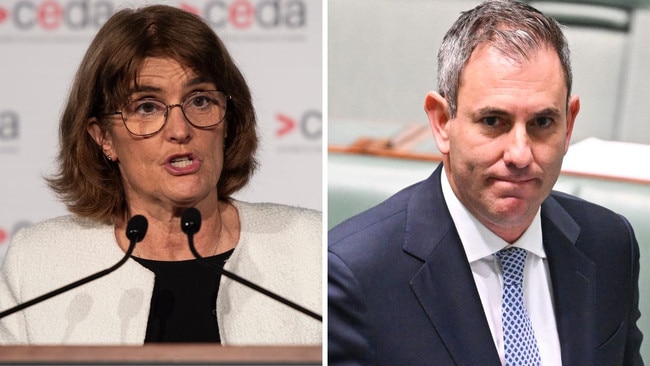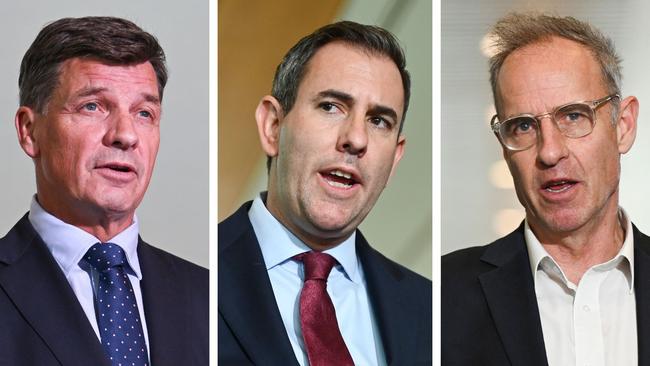RBA governor Michele Bullock schools Jim Chalmers on reading inflation data
Michele Bullock has delivered a blow to Jim Chalmers’ emphasis of the reduction of headline inflation figures, arguing that underlying measures were the ‘best way’ to measure price pressures across the economy.

Reserve Bank governor Michele Bullock has delivered a blow to Jim Chalmers’ repeated emphasis of the reduction of headline inflation figures, arguing that underlying measures were the “best way” to measure price pressures across the economy.
Ms Bullock’s declaration she was focused on elevated levels of underlying inflation came as the Treasurer was handed a major win after securing passage through the Senate for his long-stalled RBA revamp.
Dr Chalmers on Wednesday lauded new figures showing inflation in the year to October had slowed to 2.1 per cent, declaring it was the third consecutive month prices growth had come within the central bank’s 2-3 per cent target band.
But in a speech on Thursday night, Ms Bullock declared the RBA would “look through” the reduction in the headline measure when considering interest rates as it had been distorted by Labor’s power bill rebates.
“Despite the decline there is still some way to go to return inflation sustainably within our 2-3 per cent target range,” she told the Committee for Economic Development Australia’s annual dinner in Sydney.
“Indeed, over the past year, part of the decline in headline inflation has been due to temporary factors such as electricity rebates and declining fuel prices.
“While these temporary factors have undoubtedly helped many Australians, our approach is to look through them to some extent to better understand where inflation will settle in the medium term. The best way to do this is to look at underlying inflation. The measure we typically look at for this is trimmed mean inflation and by this measure, inflation was still too high.”
Ms Bullock’s comments follow the release of fresh inflation data on Wednesday, which showed the RBA’s preferred trimmed mean gauge – which excludes more volatile price changes – lifted to 3.5 per cent in the year to October, up from 3.2 per cent in September.
While the Albanese government has pinned its hopes on interest rate cuts before the election to improve its standing with voters, in recent weeks analysts and economists have revised their rate cut bets amid signs of stubborn underlying inflationary pressures.
On Thursday, markets were fully priced for a quarter percentage point cut at the RBA’s May 20 board meeting, just four days before the cut-off for a federal election, while leading economists, including forecasters at Westpac and NAB, are also predicting a move lower then.
As Ms Bullock resisted Dr Chalmers’ focus on headline inflation, Labor received a win in the Senate on its final sitting day of the year, securing Greens and crossbench support for its overhaul of the central bank.
The reforms, which follow a sweeping review of the RBA last year, will create a new dual board structure at the RBA, one charged with setting interest rates and another overseeing the institution’s governance.
Welcoming the passage of his legislation through the Senate, Dr Chalmers said the changes would ensure the RBA remained “world class” and fit to meet Australia’s future economic challenges.
“These laws will reinforce the Reserve Bank’s independence, clarify its mandate, and modernise its structures,” he said.
But in a break from the review’s recommendations, Labor voted in support of Greens’ amendments to the legislation in order to secure its passage, retaining two key aspects of existing legislation that Dr Chalmers had initially proposed to scrap.
The first is the treasurer’s never-before-used power to override RBA monetary policy decisions, which the Greens argued is essential to preserve given its abolition would leave monetary policy decisions in the hands of “unelected technocrats”.
The second is the RBA’s power to direct the lending activity of commercial banks to certain economic sectors. Retaining this component of the legislation will allow the RBA to direct credit into “desirable parts of the economy”, such as renewable projects, the Greens say.
While the Greens had previously demanded the government direct the RBA to cut interest rates in return for its support, on Thursday that demand was dropped, with Greens economic justice spokesman Nick McKim claiming it was up to Dr Chalmers to explain why he hadn’t exercised his power to overrule the central bank.
“We make no apologies for putting that issue front and square on the agenda so people understand that the government does actually have the power,” Mr McKim said.

Independent Tasmanian senator Jacqui Lambie also supported the Labor legislation, as did ACT independent David Pocock. However, a separate amendment he moved that would have required the RBA to give “equal consideration” to protecting jobs and keeping inflation low was killed off by Labor.
Opposition Treasury spokesman Angus Taylor, who in September backed out of supporting the reforms after previously providing his in-principle support, accused Dr Chalmers of “doing a dirty deal with the Greens” to secure the minor party’s votes, demanding Anthony Albanese step in to “kill” the agreement.
“By voting with the Greens on the RBA, rather than accepting the Coalition’s clearly articulated red line issues, the Treasurer has confirmed he aligns with the Greens on calling for the Reserve Bank governor to be sacked, on calling for the Reserve Bank to direct Australian businesses’ access to finance,” he told the parliament.
The changes to establish the new specialist rate-setting board came after the RBA review found existing board members collectively lacked the expertise to challenge the interest rate decisions of the governor and had not opposed their recommendation in the past decade.
While Ms Bullock, RBA deputy governor Andrew Hauser and Treasury secretary Steven Kennedy will transfer to the new rate-setting board, at least one of the six existing board members has expressed an interest in transferring to the governance board, The Australian understands. That would allow Dr Chalmers to make further appointments to the new rate-setting board following his appointment of two ex-ACTU officials in 2023.
Other recommendations of the RBA review, including that its board hold fewer meetings and that they are followed by a press conference from the governor, have already been adopted by the central bank.




To join the conversation, please log in. Don't have an account? Register
Join the conversation, you are commenting as Logout